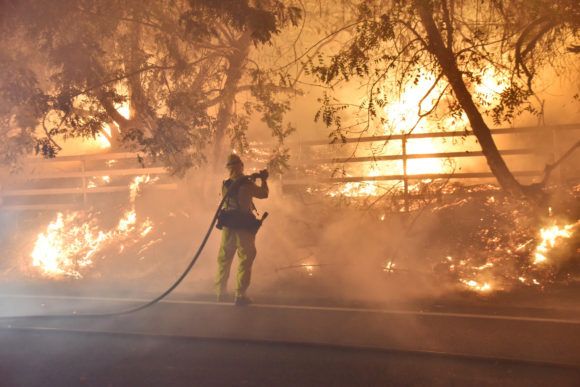A growing homeowners insurance crisis for Californians is straining brokers who must work harder to get increasingly expensive and more frequently unavailable coverage for their clients, a crisis many of them blame on regulations and wildfires.
Wildfires have made the state a bad bet for struggling carriers—and this season so far looks to be another challenging one for the state.
A growing insurance provider pullback from the state’s homeowners market—carriers pulling back have blamed wildfire losses as well as regulations—has driven brokers to take buyers into the state’s FAIR Plan, a limited and expensive last resort.
Brokers are also taking clients to the surplus lines market, where more buyers are now getting coverage. With the year only half over, homeowners insurance transactions in California’s surplus lines are up 70% for 2024, doubling the total 10 years ago. That follows a massive increase in homeowners surplus lines transactions last year.
Regulators have proposed fixes, but some brokers see it as a case of “too little, too late,” as admitted market options appear to be dwindling and less inviting in a state that’s been plagued by numerous and record wildfire losses in recent times.
State Farm has applied for large rate increases in California, a year after the carrier got rate approvals of 7% and 20%. The insurer, the largest in California, insures nearly one-in-five homes in the state. It recently requested a 30% rate increase for its homeowners line, a 52% rate increase for renters and 36% rate increase for condo coverage.
Allstate, which stopped issuing new California homeowners insurance policies in 2022, is seeking an increase in its California homeowners insurance premiums by an average of 34%. It would be the largest rate increase this year and would impact more than 350,000 policyholders.
Those are two among several carriers that have pulled back writing homeowners in California. The companies have offered numerous reasons for their decisions, but a report from Gallagher Re released late last year showed the threat of damaging wildfires in conjunction with inflation and pricing challenges has led to a distressed insurance and reinsurance market, particularly in California.
Brokers
The bad news is being delivered to homeowners by brokers, who must work harder and longer hours to find ways to satisfy increasingly dissatisfied customers.
“I’ve had clients pull out of buying a house because the only option was the California FAIR plan, which was a non-option for them,” said Lacey Garrison Strom, executive vice president, director of family office, for Walnut Creek, California-based Heffernan Insurance Brokers. “Or they were buying a house and the house that they were buying was over the $3 million (limit) that you can get with a FAIR Plan and they needed a loan, so they couldn’t actually buy that house because the lender wouldn’t accept a FAIR Plan policy. So, we’re seeing a lot of that, and not many people can afford the premiums.”
The process of securing homeowners insurance for a client is much different than five years ago, when it took as little as an hour. Today, it can take days or weeks to get a response from a carrier, Strom said.
“It affects the way you deal with clients, or you’re losing clients or you’re just having to spend a lot more time dealing with them or looking for coverage for them,” she said. “I would say we’re spending a lot more time with our clients, a lot more time on the phone with underwriters, a lot more emails going out with submissions to underwriters and wholesale companies to try to find coverage when we didn’t have to do that five years ago. We had options then; now we’re lucky if we have one option, so the stress that it puts on our service team is exponential.”
Jim Tolliver, who started out in the insurance business with global broker Marsh in the 1990s, has seen the process of finding insurance for homeowners change dramatically.
Tolliver, who oversees a large team of brokers as vice president, national practice leader—private client group with Woodruff Sawyer, has advised his team to prioritize helping their clients stay with their current carrier.
“So, what we tell our insured a lot of times is ‘Don’t rock the boat…be very careful about submitting claims,'” he said.
Just a few years ago if, for example, a homeowner incurred a small amount ($8,000 or so) of damage, brokers encouraged insureds to file a claim. That’s no longer what they do.
“We’re telling people at this point, ‘Think of insurance in a catastrophic way, don’t submit small claims, and really let’s do everything we can to minimize any concerns from the carrier,’ and that’s probably the best thing we can do in the short term,” Tolliver said.
Like Strom, he is also more often encountering potential home buyers who can’t get insurance, or people who want to sell their home but cannot because buyers are unable to get insurance to secure a loan.
When coverage is offered, lenders are increasingly having to scrutinize it, and buyers and their brokers should too, he advised.
“It used to be that a lender would say ‘Go out and make sure you have coverage for the home,’ and when you’d send them a declarations page, they just checked the box,” Tolliver said. “Now, you really should look at the coverage, because it may have a 50% wildfire deductible on there, it may have less than the full insurance to value on that home or they may not be insuring it.”
Tolliver and his team deal with a lot of expensive properties, a space where rate hikes and lack of availability have been exacerbated—even for homes that aren’t in areas considered extremely high wildfire risk.
He recently worked to secure insurance on a $33 million home in 90210 ZIP code (Beverly Hills) for which the best loss limit they could get was $15 million.
“And they had a $2 million wildfire deductible, so that’s when it gets really tough—to kind of have the homeowner go ‘Wow, I’m going to spend $400,000 or $500,000 on insurance and I’m getting that kind of coverage. That really starts to make me wonder if it’s worth my time,'” Tolliver said. “So, people are self-insuring.”
Proposals
The state’s insurance commissioner and other stakeholders have so far responded to the California homeowners insurance crisis with myriad proposals.
Modeling could be used in ratemaking under a proposal being considered by Insurance Commissioner Ricardo Lara, which is being supported by the insurance industry. It is among several proposed steps, which include expedited rate filings and enabling insurers to factor reinsurance costs into rates.
U.S. Rep. Adam Schiff, a California Democrat who’s running for the Senate, is seeking to rein in soaring home insurance rates that he says are “gouging” his constituents with the Incorporating National Support for Unprecedented Risks and Emergencies Act, a federal reinsurance option he believes will be a cheaper alternative. The bill would require participating insurers to offer comprehensive coverage for wildfires, storms and floods, among other risks. Schiff said he would model the proposal after the Terrorism Risk Insurance Act.
A new proposal would require the California Department of Insurance to respond to rate requests from insurers in 120 days. If an insurer requests a rate hike on an average of more than 7%, the CDI must provide insurers with a suggested rate in 120 days.
In Tolliver’s view, even what he believes are sensible proposals—such as allowing reinsurance to be factored into ratemaking, the use of catastrophe modeling, and expedited rate hearings—may be a case of “too little, too late” action from regulators who he believes should have embraced these ideas a decade ago.
The amount of time it takes for a rate approval is lengthy, but Tolliver said the true experience for carriers may be far more drawn out than most believe.
“I don’t care what they’re publishing in the media to promote themselves in the division of insurance side, when I talk to my best relationships with these large national carriers, it is taking over 365 days to get a basic rate increase pushed through,” he said. “You have the state saying that the average is 196 days and they’re going to move it down to 120 (under the new proposals), but to me that’s very inefficient regulation.”
He and others spoken with for this article also take issue with a quid pro quo exchange proposed in which carriers that want to stay in the state must continue to write some coverage in higher risk wildfire areas in exchange for requested rate hikes.
“I’m not sure that when you’re suffering major underwriting losses and you’re really needing to get rate…that’s something that a good businessperson is going to run towards,” Tolliver said.
Including catastrophe modeling is seen by most of the industry as one good way to help with the crisis.
Traditional risk evaluation has “proven inadequate in the face of evolving wildfire threats” because the underwriters “rely on outdated assumptions and incomplete data sets that fail to recognize the full extent and complex interactions between drivers of wildfire risk and changes in extreme fire behavior,” according to a recent Swiss Re blog outlining ways to redefine wildfire underwriting.
“Fires causing their own weather, crossing the Sierra crest, burning the same landscape in consecutive years, and entering urban landscapes are all recent examples of phenomena that were often not accounted for in modeling until well after they had caused major insured losses,” the blog states.
However, consumer advocates like Consumer Watchdog say the “black-box” models shield carriers from having to sufficiently explain requested rate hikes.
Many of the proposed changes indicate a growing interest in changing Proposition 103, the 1988 voter-approved law that requires prior approval from the CDI before implementing property/casualty insurance rates.
The American Property Casualty Insurance Association has favored changing Prop 103 for years, and the group believes that streamlining approvals is key to addressing the California insurance crisis.
“What we’re hearing from our members is adequate rates in a timely manner,” said Laura Curtis, assistant vice president for state government relations for the Western region of APCIA.
She cited data from the National Association of Insurance Commissioners showing California insurers have paid out $1.13 and taken in $1 in the last decade to insure homeowners.
Wildfires in California are a big concern from carriers, but many members Curtis has heard from say they believe that clearing regulatory hurdles will be enough to make it profitable to write homeowners insurance in the state and bring those that left back to the market.
“They are not saying that California is not insurable,” Curtis said.
Consumer Watchdog is against many of the proposals being made beside the group’s reservations about modeling in ratemaking. The group has said the changes proposed in the governor’s budget and those under consideration by Lara “would undercut independent public scrutiny of insurance rate increases,” and put at risk a process the group says has saved Californians $6 billion on their insurance.
“The governor’s plan invites insurance companies to set their own prices and will kill public participation in rate review,” stated Carmen Balber, executive director of Consumer Watchdog. “It takes away the insurance commissioner’s ability to make insurance companies justify their charges and turns the Department of Insurance into a rubber-stamp for rate increases. It guts the public intervenor process and will cost insurance consumers billions in savings from future public rate challenges.”
Surplus Lines
The growing void in homeowners coverage is being filled by the state’s FAIR Plan and surplus lines.
Michael Cotsenmoyer, president of JE Brown & Associates, a Walnut Creek-based wholesale insurance brokerage offering personal, commercial, and professional lines products, has seen an uptick in his business in the last few years as homeowners run out of good options in the admitted market.
“The way it’s affected our business is we have been just deluged with submissions,” Cotsenmoyer said.
“When State Farm made their move, that was kind of the real catalyst. We began to see that deluge of submissions, so by mid-summertime last year, we were just experiencing a tremendous uptick in volume, and going into the end of the year, we anticipated a bit of slowing from some of our markets simply because of capacity constraints—you know everybody has their limitations,” Cotsenmoyer said. “What I didn’t realize is that more of these admitted insurers were putting the brakes on, and so as you saw the appetite shift. In our non-admitted markets, we were still maintaining the volume.”
And the volume of business from California homeowners and their brokers coming to his firm in need of coverage has not let up.
“In fact, we’re growing as a result of it,” he said. “And we’re well positioned based upon the way we transact business, and the markets that we work with and the carrier partners that we have.”
He’s also seeing non-admitted carriers start to change the way they do business, and they are lately starting to “mimic in some ways the admitted carriers.”
For example, several non-admitted carriers are offering direct billing and payment installments, likely in part to meet consumer expectation for such common services, but Cotsenmoyer also believes it’s to take advantage of the benefits of retention through these conveniences.
“There’s an interesting sort of landscape taking shape now as we have these non-admitted insurers, which are a little more flexible, coming to fill that void that was presented by your State Farms and you name it,” he said. “And so, we’re helping to place a lot of those risks that are otherwise going to end up in the FAIR Plan.”
Data from the Surplus Line Association of California on homeowners transactions in surplus lines in California shows a jump in transactions from 34,783 in 2022 to 50,420 in 2023.
There have been 72,150 homeowners transactions in California surplus lines to date this year, a 70% increase over last year’s total, according to the SLA-Cal.
The CDI when reached out to for comment provided an emailed response asserting that the steps Lara and the department are taking, which fall under a so-called Sustainable Insurance Strategy, will address “decades-long neglected issues and outdated regulations which have led to the insurance crisis many Californians are facing.”
“Our goal is to create a modern, sustainable insurance market that incentivizes safety and reduces risks. It does not retreat from high-risk areas but instead utilizes a long-term strategy to continue providing coverage to consumers,” the statement reads. “We are doing this by streamlining the rate application process, introducing risk management tools such as catastrophe modeling and net cost of reinsurance, with a commitment from insurance companies to write new and expanded coverage in more areas of our state, especially in wildfire distressed areas, and strengthening the FAIR Plan.”
According to the statement, the department is on track to implement its strategy by the end of the year.
State Farm
The biggest impact to California homeowners for now would come from the State Farm rate hike, which could affect an estimated 1.2 million homeowners.
The insurer has said rates will help shore up its financial situation following massive losses from wildfires and other natural catastrophes.
State Farm is “working toward its long-term sustainability in California,” according to a statement from the company.
“Rate changes are driven by increased costs and risk and are necessary for State Farm General to deliver on the promises the Company makes every day to its customers,” the statement reads. “We continue to look for ways to maintain competitive rates and help our customers manage their risk.”
Last year, State Farm announced it had stopped accepting new policy applications for property/casualty insurance in California due to increased risks from wildfires and inflation. More recently, State Farm said it would non-renew 30,000 California homeowners, rental dwelling, and other property insurance policies.
Tokio Marine America Insurance Co. and Trans Pacific Insurance Co., in April announced plans to withdraw from the wildfire-prone state entirely starting in July. In June, The Hartford confirmed it will discontinue writing new homeowners policies in California.
Other large carriers that have announced a reduced appetite for writing California homeowners insurance include American International Group (AIG) and Chubb.
Allstate in an emailed statement on its rate request explained: “Our payments to help California residents recover from accidents and disasters have increased significantly in recent years due to higher repair costs, more frequent and severe weather and legal system abuse.”
Strom believes that until regulators figure things out and carriers get some rate hikes, she and her clients will just have to do their best—which means working harder for her and her team, and for her clients, it means paying much more for their insurance.
“We’re just so unbalanced when it comes to how much we should be charging versus how much we are charging and until the regulators figure out how they feel like they can properly approve these increases, we’re never going to feel relief,” she said. “So, they really do have to figure this out and not just ignore the problem.”
Topics California Agencies Homeowners
Was this article valuable?
Here are more articles you may enjoy.



 Travelers Income Drops 65% on Catastrophe Losses, Primarily California Wildfires
Travelers Income Drops 65% on Catastrophe Losses, Primarily California Wildfires  Class Action Accuses Toyota of Illegally Sharing Drivers’ Data With Progressive
Class Action Accuses Toyota of Illegally Sharing Drivers’ Data With Progressive  Trump’s Trade War Is Making US Farmers Anxious About Demand Risk
Trump’s Trade War Is Making US Farmers Anxious About Demand Risk  Potential Tariff Auto Severity Impact on Travelers: Single-Digits or Less
Potential Tariff Auto Severity Impact on Travelers: Single-Digits or Less 

